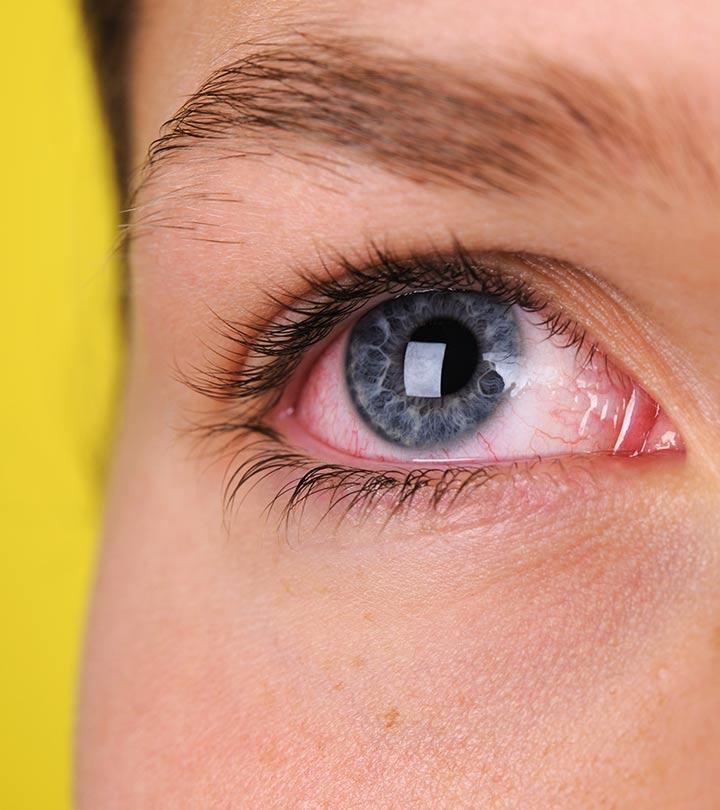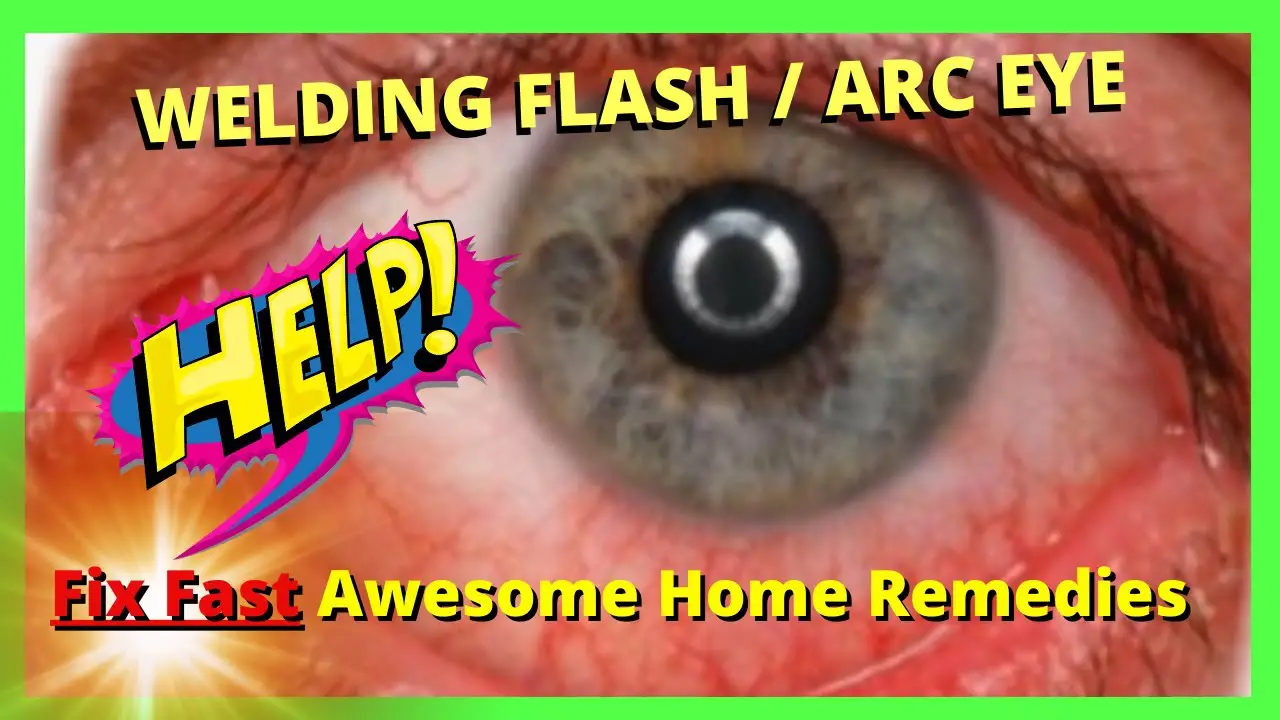To fix a welders eye, use topical antibiotic eye drops or ointment made for the eyes and take pain control medication. Additionally, using cold packs over the eyelids, staying indoors, and avoiding light sources can alleviate the symptoms of the welder’s eye.
It is a painful condition caused by exposure to ultraviolet radiation, and it damages the cornea, which can lead to infection and vision problems. Welder’s eye can cause discomfort, redness, tearing, and sensitivity to light.
Therefore, it’s essential to take precautions and use safety equipment such as protective eyewear and helmets when welding to prevent this condition.
Understanding Welder’s Eye
Welder’s eye, also known as arc eye or photokeratitis, is a painful condition caused by exposure of the eyes to high-intensity light, usually from welding. Treatment may include using topical antibiotic eye drops or ointment, dilating drops to relax the eye muscles, and pain medication.
Cold packs can also help soothe pain and irritation. Welder’s eye, also known as arc eye, is a painful eye condition that occurs when the eye is exposed to bright welding light.
Welding arcs emit ultraviolet (UV) and infrared (IR) radiation which can damage the eye’s surface causing painful inflammation and blurred vision. Understanding the causes and symptoms of welder’s eye is essential to taking preventive measures and seeking proper treatment.
Causes Of Welder’s Eye
The welder’s eye is caused by prolonged exposure to bright light produced by welding arcs. The UV and IR rays emitted by the welding arc damage the surface of the eye causing inflammation, pain, and blurred vision. Welding arcs can emit up to ten times the amount of UV radiation produced by the sun, making it a serious risk to eye health.
Symptoms Of Welder’s Eye
The symptoms of a welder’s eye can range from mild to severe and may not appear until several hours after exposure. Some common symptoms of welder’s eye include:
- Pain ranging from mild pressure to intense pain
- Tearing and redness of the eye and surrounding membranes
- The sensation of “sand in the eye”
- Abnormal sensitivity to light
- Inability to look at light sources (photophobia)
It is essential to seek medical attention if you experience any of these symptoms to avoid long-term damage to your eyes. Treatment options include medication, cold compresses, and resting your eyes to allow them to heal.
In conclusion, understanding the causes and symptoms of a welder’s eye is critical in taking preventive measures and seeking treatment. Proper eye protection, including welding helmets and eye shields, can prevent the welder’s eye. Regular eye check-ups and prompt medical attention can minimize the effects of the welder’s eye and protect your vision.

Credit: trainingexpress.org.uk
Treatment For Welder’s Eye
Welder’s eye, also known as arc eye, can be treated with topical antibiotic eye drops or ointment to prevent infection in the damaged cornea. Pain control can be achieved through oral medication, and cold packs over the eyelids may also soothe pain and irritation.
It is important to avoid sunlight and remove contact lenses during treatment. There is no effective medical treatment for solar retinopathy, which can cause permanent vision loss.
Treatment for Welder’s Eye
A welder’s eye or arc eye is a common eye injury that welders experience due to exposure to high-intensity UV light. The condition is treatable, and there are various methods for treating welder’s eye, including medical treatment and home remedies.
Medical Treatment
If you suspect that you have a welder’s eye, you must seek medical attention right away. Eye doctors or ophthalmologists recommend the following medical treatments for welder’s eye:
• Topical, antibiotic eye drops or ointment that are made specifically for the eyes may be recommended to prevent infection in the damaged cornea.
• A short-acting drug can be used to paralyze the ciliary muscles of the eye, resulting in a fixed and dilated pupil.
• Oral medication can be used for pain control.
Home Remedies
In addition to medical treatments, many simple home remedies can help in the treatment of welder’s eye. Some popular home remedies include:
• Cold packs can be placed over the eyelids to soothe pain and irritation.
• Avoid contact lenses during the exposure and treatment of arc-eye. Also, stay indoors as much as possible to avoid the sun.
• Take prescribed doses of painkillers and medication regularly.
• Artificial tear drops or ointment can relieve some symptoms.
• Cover the eyes with a padded dressing to rest them and allow them to heal.
Welder’s eye can be painful, and it is essential to take immediate action if you experience any symptoms. Medical treatment can help in preventing further damage to the cornea and other structures of the eye.
Home remedies are also effective in reducing pain and allowing the eyes to rest and heal. If you are a welder, always take adequate measures to protect your eyes from the damaging effects of UV light. Use appropriate protective gear and avoid exposure to bright light whenever possible.
Preventing Welder’s Eye
Welder’s eye, also known as arc eye or photokeratitis, can be prevented by wearing welding goggles or helmets that have appropriate shade lenses. If you develop a welder’s eye, medication such as antibiotic eye drops or oral painkillers can help ease symptoms.
Over-the-counter cold packs can also be used to soothe pain and irritation.
Preventing Welder’s Eye
Welder’s Eye is a painful condition that can lead to short-term and permanent vision loss in welders. However, it’s not too difficult to prevent this condition, and it only takes a few precautions and habits that can greatly decrease the risk of developing it. Here are some essential methods to prevent Welder’s Eye:
H3: Wearing Protective Eyewear
Wearing a protective face shield or goggles while welding can greatly reduce the risk of developing a welder’s eye. They can protect the eyes against flying debris, harmful UV rays, and radiant energy from welding arcs.
The best protection is provided by a durable, dark-shaded face shield, or goggles with side shields that can protect the eyes from all angles. It is important to note that regular eyeglasses are not suitable protection for a welder’s eye, as they cannot provide adequate protection against splashes, dust, or welding fumes.
Limiting Exposure Time
Another effective way to prevent Welder’s Eye is by carefully managing exposure time to welding arcs. Welders should take frequent breaks when welding and avoid exposing themselves to welding arcs for long periods of time.
After a break, it is recommended to close the eyes for several minutes, wear a protective facemask or goggles, or go to a separate room to rest the eyes and avoid overexposure to harmful radiation.
Proper Eye Care
It is equally important to take care of the eyes properly after welding to prevent further complications. Rinse the eyes with cool water for several minutes to help reduce discomfort and irritation caused by Welder’s Eye. Do not rub the eyes because it can cause further damage.
If you are experiencing discomfort, see an eye doctor promptly to immediately treat the issue before it becomes more severe.
By following these simple methods, welders can prevent Welder’s Eye and safeguard their sight. Taking preventative measures now can save you from experiencing pain and vision problems in the future. Remember to prioritize your eye health when welding to prevent any long-term damage.

Credit: www.reddit.com
Arc-eye Vs Welder’s Flash Vs Photokeratitis
Arc-Eye, welder’s flash, and photokeratitis are all eye conditions caused by exposure to UV radiation from welding, leading to symptoms like pain, redness, and sensitivity to light. To fix a welder’s eye, it is recommended to seek medical attention and use cold packs, painkillers, and antibiotic eye drops or ointments to reduce infection and soothe irritation.
Additionally, avoiding exposure to UV radiation by wearing protective gear and staying indoors can prevent these conditions from occurring.
Differences Between Arc-Eye, Welder’s Flash, and Photokeratitis
When it comes to welding, there are three common terms that describe the eye injury caused by the intense light produced during the welding process: arc-eye, welder’s flash, and photokeratitis. These conditions are similar in symptoms but differ in their severity, causes, and treatment. Here’s a closer look at the differences between them:
Arc-Eye:
Arc-eye, also known as welder’s eye, is a painful condition that occurs when the ultraviolet (UV) rays emitted by the welding arc burn the surface of the eyes. The symptoms of arc-eye include redness, tearing, swelling, and a gritty sensation in the eyes.
In severe cases, arc-eye can cause temporary vision loss. Arc-eye typically resolves on its own within 48 hours, but it can be prevented by wearing proper eye protection, such as a welding mask or goggles.
Welder’s Flash:
Welder’s flash, also called corneal flash burns or flash burn of the eye, is a condition similar to arc-eye, but it’s caused by exposure to other sources of intense UV light, such as sunlamps or tanning beds. The symptoms of welder’s flash are similar to arc-eye, but they can take longer to develop.
Welder’s flash can also cause a feeling of pressure behind the eyes, headaches, and sensitivity to light. Treatment for welder’s flash is similar to that of arc-eye, and it usually resolves within a few days.
Photokeratitis:
Photokeratitis, also known as snow blindness, is a condition caused by exposure to UV light reflected off snow, sand, water, and other surfaces. It’s similar to welder’s flash, but the symptoms can be more severe and long-lasting.
Photokeratitis can cause blurred vision, extreme sensitivity to light, and temporary vision loss. Treatment for photokeratitis may involve eye drops, pain relievers, and avoidance of bright light until the eyes have fully healed.
In conclusion, while arc-eye, welder’s flash, and photokeratitis share similar symptoms, they have different causes and treatments. It’s important to wear proper eye protection when welding or working with other sources of intense UV light to prevent these conditions.
If you do experience eye injury from welding or other activities, seek medical attention promptly to avoid complications and ensure a speedy recovery.
What To Do If You Have Welder’s Eye?
Welder’s eye, also known as arc eye or photokeratitis, can be incredibly painful. To fix welder’s eye, it’s important to seek medical attention and follow the prescribed treatment plan.
This may include using antibiotic eye drops or ointment, taking pain medication, and avoiding exposure to bright light. Self-care measures, such as using cold packs and removing contact lenses, may also provide relief.
If you’ve been welding for a while, then you might have experienced a welder’s eye, also known as arc eye or photokeratitis. This condition occurs when ultraviolet rays from the welding process damage the cornea of your eyes.
Symptoms can include pain, tearing, redness, and sensitivity to light. If you think you have welder’s eye, then there are several things you can do to alleviate your symptoms depending on the severity of your condition. In this article, we will explore what to do if you have welder’s eye by discussing first-aid tips and when to seek medical attention.
First-aid Tips
If you suspect that you have welder’s eye, the first thing you should do is stop welding and remove your helmet immediately. Once you’ve removed your helmet, flush your eyes with clean, lukewarm water for at least 20 minutes.
You can also use artificial tears to help soothe your eyes and reduce any burning or pain. Cold compresses can also help with pain relief and swelling. Over-the-counter painkillers like ibuprofen can also help manage your pain.
When To Seek Medical Attention
In most cases, welder’s eye is a self-resolving condition that will heal on its own within a few days. However, if your symptoms persist, or if you experience a loss of vision, then it’s essential to seek medical attention.
Treatment options for welder’s eye typically involve medicated eye drops or ointments that can help reduce inflammation and protect your eyes from infection. In extreme cases, your doctor may also prescribe painkillers or refer you to an eye specialist for further treatment.
In conclusion, welder’s eye is a common condition that can be easily treated with proper first-aid and medical attention. Remember to always wear proper eye protection when welding to prevent welder’s eye from occurring in the first place. If you experience any unusual or severe symptoms, don’t hesitate to seek medical attention immediately.
Tips For Welders
If you are a welder and looking for ways to fix welder’s eye, there are several self-help remedies that you can take into consideration. These include using cold packs over the eyelids to soothe pain and irritation, removing contact lenses, taking painkillers and medication regularly, and avoiding sun exposure by staying indoors as much as possible.
It is also recommended to seek out medical treatment, such as using antibiotic eye drops or medication for pain control. As a welder, you may be familiar with the discomfort of experiencing welder’s eye, also known as arc eye or photokeratitis.
This painful condition occurs when your eyes are overexposed to the ultraviolet rays produced by welding arcs. Symptoms may include pain, redness, light sensitivity, and the feeling of having sand in your eyes.
Fortunately, there are ways to treat and avoid welder’s eye. In this post, we’ll provide you with some tips to help you protect your eyes and stay comfortable while you work.
Avoiding Welder’s Eye
The best way to prevent welder’s eye is to limit your exposure to welding arcs in the first place. Here are some tips to keep in mind:
- Wear a welding helmet with a proper shade rating for the type of welding you’re performing
- Use curtains, partitions, or other barriers to block the welding arc from other workers or nearby bystanders
- Avoid looking directly at the welding arc while working
- Take breaks to rest your eyes frequently, especially if you’re working on a large project that requires extended periods of welding
Choosing The Right Personal Protective Equipment
Another way to protect your eyes is by wearing the right PPE for your job. This can include:
| PPE | Description |
|---|---|
| Welding helmet | Provides head and facial protection while also regulating the amount of light that reaches your eyes |
| Welding goggles | An alternative to welding helmets that can provide a closer fit and better peripheral vision |
| Safety glasses | A lightweight, more comfortable option for shorter welding tasks that still provide impact and light protection |
Make sure to choose PPE that meets the appropriate safety standards for your work environment and that is comfortable to wear for extended periods. Proper PPE will significantly reduce the risk of welder’s eye.
Remember, protecting your eyes while welding is crucial to avoid experiencing welder’s eye symptoms. Use proper techniques, and PPE, and take breaks when necessary to reduce the likelihood of injury.
If you do experience symptoms of welder’s eye, it’s important to seek medical attention from an eye care professional who can prescribe appropriate treatment and help you manage your symptoms.

Credit: www.stylecraze.com
Frequently Asked Questions For How To Fix Welders Eye
How Do You Treat Welder’s Eyes?
Topical, antibiotic eye drops or ointment may be recommended to prevent infection in the damaged cornea. Pain can be controlled with oral medication. Self-help remedies include using cold packs over the eyelids and avoiding wearing contact lenses. Resting the eyes with a padded dressing and avoiding sun exposure can also help.
Vision loss from solar retinopathy may be permanent. Symptoms include pain, tearing, redness, sensitivity to light, and the sensation of “sand in the eye. ” It is best to see your eye doctor for proper diagnosis and treatment.
What Is A Home Remedy For Arc Eye?
A home remedy for arc eye is to use cold packs over eyelids to soothe pain and irritation. Remove contact lenses and stay indoors as much as possible to avoid sunlight. Painkillers and medication can provide relief. However, for severe cases, topical antibiotic eye drops or ointment may be recommended to prevent infection.
Oral medication can also be used for pain control.
How Long Does It Take For A Burned Retina To Heal?
There is no effective medical treatment for a burned retina, also known as solar retinopathy. In some cases, vision may improve without treatment over a period of weeks or months. However, vision loss from a retina burn is often permanent.
What Are The Symptoms Of Welders Eye?
The symptoms of welders eye include pain, tearing, redness, sensitivity to light, and feeling like there is sand in your eyes. Treatment may involve using cold packs, painkillers, and medication. Eye drops or ointments made for the eyes may also be necessary to prevent infections in the damaged cornea.
In severe cases, oral medication can be used for pain control. It is important to take precautions to avoid welders eye, such as wearing protective clothing, using proper ventilation, and avoiding direct eye contact with welding arcs.
What Is Welder’s Eye And How Do You Get It?
Welder’s Eye is a condition caused by exposure to bright light when welding or torch cutting. It can also be caused by prolonged exposure to the sun or snow glare, or from using tanning beds without protective eyewear.
Conclusion
Welder’s eye is a painful and frustrating condition that can be prevented and treated with proper measures. Prevention methods such as wearing appropriate protective gear and taking breaks are crucial in avoiding the condition altogether.
In cases where a welder’s eye occurs, seeking medical attention and using home remedies such as cold packs and painkillers can alleviate symptoms and aid in the healing process.
By following these guidelines, we can protect ourselves and others in the welding industry from the dangers of the welder’s eye.


